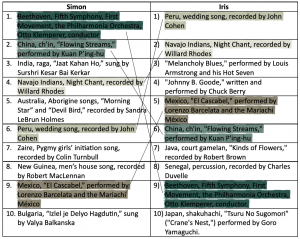Links: My post for Task 8; Simon’s post for Task 8
I chose to link Simon’s post because we have similar choices from the 27 songs. Among the ten pieces of music we chose, five were the same. Therefore, I thought it would be a good idea to dive deeper into Simon’s post to find the similarities and differences between our song-choosing criteria.
Tool used
We are both using WordPress on UBC Blogs, so the content-authoring capabilities for our sites should be similar. However, we use different themes, resulting in differences in the end-user interface. For example, his theme’s background and text color are white and black, respectively, while mine is reversed. Also, the text size for my theme is larger than Simon’s, which means my post would appear longer but easier to read on devices with smaller screens. Moreover, the “recent posts” and “recent comments” sections for his theme always appear at the right of the blog content regardless of the changeable page size, making it more convenient for users to check other posts.
For this task, we both primarily used text to present our criteria for choosing the ten pieces of music. I used a Genially interactive map to show the songs I picked and the countries they are from. Simon mainly used text to show his selections and brief reasons, as well as his reflection on this task.
Song list comparison

Criteria comparison
Similarities
1. Universality
We both included the universality of music in our criteria. Simon believed these songs must feature meaningful and universal themes that transcend language and culture. I thought universally understood music would have a better chance of being understood by a wide range of potential extraterrestrial life forms. Therefore, we chose simple and intuitive music unrelated to specific linguistic contexts.
2. Human values
We both appreciated universal human values. Simon mentioned “love, hope, and unity” (Worley, 2023), while I thought of “love, cooperation, and empathy” (Wang, 2023). I believe that incorporating aspects of human values can help represent the best aspects of humanity.
3. Cultural diversity
Both of us paid attention to revealing humans’ cultural diversity. In order to present a more comprehensive representation of human expression, experiences, creativity, and culture, we were mindful to add recordings from various geographical areas.
4. Balance between instruments and human voices
Simon aimed for “a balance between instrumental and vocal recordings” when choosing songs (Worley, 2023). Same for me, I included five songs with human voices and the rest with different instruments. If extraterrestrial life forms have the capacity for audio communication, including human voices and various instrumental sounds could serve as a connection point.
Differences
Iris – Mathematical foundations
In the case of communicating with creatures with no hearing or living in different time scales, adding music with mathematical foundations enables an additional way of communication (Taylor, 2019). Both Bach’s and Beethoven’s music was highly twined with mathematics; I only picked Beethoven’s Fifth Symphony for personal preference and avoiding repetition.
Iris – Music genre diversity
To ensure sending a record with a highly diversified music genre, I included Jazz and blues, Rock and Roll, popular music, classical music, and pieces tied to specific cultural contexts. I believed adding various types of music would increase the chance of being comprehensible to many potential recipients.
Simon – Positive and uplifting
Simon claimed that music with positive and uplifting tones should be prioritized because “these recordings have the potential to bring joy and inspiration to those who encounter them” (Worley, 2023). I agree that expressing peaceful intent might serve as a foundation for building a positive and cooperative relationship.
Simon – Opening message
In addition to the ten pieces of music he chose, Simon suggested that an opening message should be added at the beginning of the record, explaining critical information about Earth and the purpose of sending the record.
References
Taylor, D. (Host). (2019, April). Voyager golden record. [Audio podcast episode]. In Twenty thousand hertz. Defacto Sound.
Wang, B. (2023, October 18). Task 8: Golden Record curation – Bingying (Iris) Wang-ETEC540. https://blogs.ubc.ca/etec540bingyingwang/2023/10/18/task-8-golden-record-curation
Worley, S. (2023, October 25). ETEC 540 Task 8 Golden Record Curation Assignment | Simon Worley Blog site ETEC 540. https://blogs.ubc.ca/sworley/2023/10/25/etec-540-task-8-golden-record-curation-assignment/



